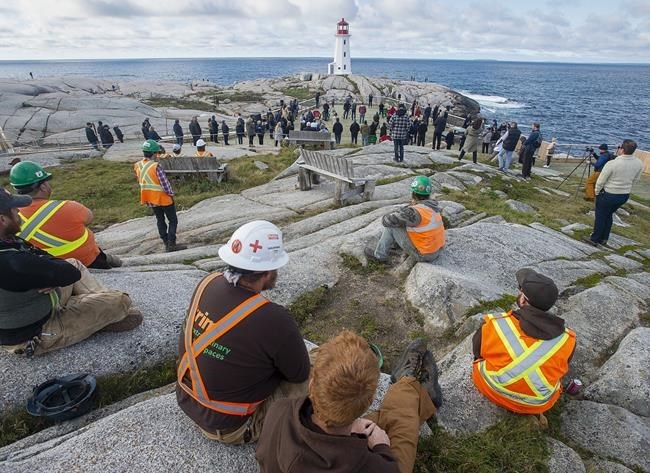PEGGY'S COVE, N.S. — About 100 people gathered near the postcard-perfect lighthouse at Nova Scotia's Peggy's Cove on Monday to mark the official opening of a viewing platform that had initially rankled some local residents.
The 1,300-square-metre deck was designed to improve access to the site and discourage sightseers from venturing onto the wave-washed rocks when storms roll in.
"This celebration recognizes the efforts of the community ... and provides a new and inclusive way to experience Peggy's Cove," Susan Corkum-Greek, the province's economic development minister, said in a statement.
More than 80 per cent of the new platform sits atop an old roadway near the Sou'Wester restaurant and gift shop. The remaining portion "extends slightly over the landscape" and is designed to blend in with the natural surroundings, the province said.
When plans for the project were unveiled in January, some residents complained the proposed deck was too big, and that its bulk would detract from the raw beauty of the rugged landscape.
There was no sign of dissent, however, during Monday's event, which included a smudge ceremony and prayer by members of the Mi'kmaw Native Friendship Centre in Halifax.
"Peggy's Cove, a treasured and timeless destination, is now accessible to people of all abilities with these beautiful, well-designed improvements," Halifax Mayor Mike Savage said in a statement. "This is a wonderful project that respects its natural environment while inviting more people to enjoy it."
The $3.1-million wood and concrete structure includes steel guardrails knitted together to look like fishing nets.
The designers have said the platform could deter thrill-seekers from getting too close to the ocean when big waves start crashing into the cove's bald rocks, but visitors will otherwise be free to roam the shoreline.
Easily one of Canada's most recognizable landmarks, the barren point of land surrounding the white-and-red lighthouse attracted more than 700,000 visitors in 2019.
Provincial officials say one in three tourists who visit Nova Scotia make a point of heading to the light — one of the world's most-photographed lightstations.
But the site can be treacherous for the uninitiated.
The smooth granite under and around the lighthouse turns black and gets slippery when the ocean surf starts heaving salt spray into the air. Rogue waves have been known to sweep onlookers into the turbulent waters.
In July 2015, a 26-year-old Ontario man was rescued after slipping into the churning sea. Three months earlier, a 25-year-old Ontario man was swept off the rocks and disappeared.
The two incidents prompted a wave of commentary on social media, much of it abuse hurled at people from outside the province unfamiliar with the fickle moods of the sea. The province responded by installing more warning signs.
Architect Omar Gandhi has said the new platform and its cantilevered look-off will be the preferred location for prudent travellers.
The project also delivered a larger parking area and visitor centre, improved traffic and pedestrian routes, new public washrooms and a new common area in the centre of the nearby village, a picturesque Maritime gem that is home to 40 residents.
A 40-minute drive southwest of Halifax, the community remains an authentic fishing village, despite the annual onslaught of tourists.
Nova Scotia contributed $1.7 million towards construction and Ottawa kicked in the rest through the Atlantic Canada Opportunities Agency.
This report by The Canadian Press was first published Oct. 18, 2021.
— By Michael MacDonald in Halifax
The Canadian Press



